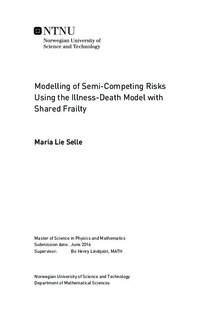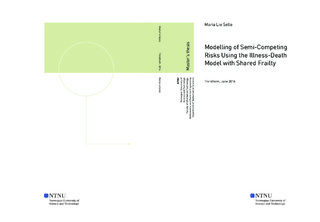| dc.description.abstract | Semi-competing risks are a variation of competing risks where a terminal event censors a non-terminal event, but not vice versa. This thesis describes and studies modelling of semi-competing risks using the illness-death model with shared frailty suggested by Xu et al. (2010) [Biometrics, 66(3):716 725]. In their model the dependency between the terminal and non-terminal failure time is incorporated through the use of a shared frailty, which gives a model with conditional transition rates possessing the Markov property. We introduce the use of parametric models for the conditional transition rates and an expansion of the model where an additional terminal event is included.
Maximum likelihood estimation is performed to fit the model to data sets. First, a simulation study is carried out. Then the model is applied to two real data sets. The first data set contains observations of leukaemia patients after bone marrow transplantation, where the non-terminal event is relapse of the disease and the terminal event is death. For this data set we compare the use of a power law function and a log-linear law function as model for the conditional transition rates and find that relapse after bone marrow transplant for leukaemia patients is associated with increased probability of death. The second data set contains observations of patients admitted to hospital intensive care unit, where the non-terminal event is hospital-acquired pneumonia and there are two terminal events, alive discharge and death on the unit. For this data set we include an additional terminal state and covariates in the model, and we find that hospital-acquired pneumonia is associated with decreased rate of discharge from intensive care unit stay, while the probability of death increases as a consequence of prolonged stay. The method makes good estimates for the model parameters and by incorporating frailties, it is simple to construct a likelihood function, and to expand the model by adding more states. The interpretation of the marginal and conditional transition rates is different, which must be taken into account when interpreting the results. The frailty of each subject is usually not accessible. Nevertheless, both the marginal and conditional transition rates are of value and both should be considered in modelling of semi-competing risk. | |

